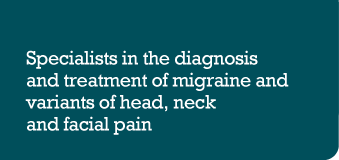Migraine Without Aura
A recurrent headache disorder manifesting in attacks which last 4-72 hours
Headache has at least two of the following characteristics:
- Pain dominates one side of the head
- Pulsating quality
- Moderate or severe pain intensity
- Aggravated by routine physical activity
The headache will include at least one of the following:
- Nausea and/or vomiting
- Intolerance of light
- Intolerance of noise
[When none of these symptoms are attributable to another cause.]
Most patients with migraine have exclusively attacks without aura. Many patients who have frequent attacks with aura also have attacks without aura.
Migraine With Aura
Recurrent disorder manifesting in attacks of reversible focal neurological symptoms, such as visual disturbances of lights or lines, tingling or numbness, that usually develop gradually over 5-20 minutes and last for less than 60 minutes, just before or at the onset of migraine headache. Less commonly, the subsequent headache lacks migrainous features or is completely absent.
Possible premonitory symptoms of Migraine with or without Aura
These can
occur from hours, to a day or two before a migraine attack. They include various combinations of :
- Fatigue, yawning and pallor
- Difficulty in concentrating
- Neck stiffness
- Sensitivity to light,
- Sensitivity to sound
- Nausea
- Blurred vision
Tension-Type Headache
Definition of Tension-Type Headache from BASH –
Episodic tension-type headache (known as TTH) also occurs in attack-like episodes, with variable and often very low frequency and mostly short-lasting – no more than several hours. Headache can be unilateral but is more often generalised. It is typically described as pressure or tightness, like a vice or tight band around the head, and commonly spreads into or arises from the neck. Whilst it can be disabling for a few hours, it lacks the specific features and associated symptom complex of migraine (although photophobia and exacerbation by movement are common to many headaches). TTH may be stress-related or associated with functional or structural cervical or cranial musculoskeletal abnormality, and these are not mutually exclusive. Clinically, there are cases where stress is obvious and likely to be aetiologically implicated (often in headache that becomes worse during the day) and others where it is not apparent. Equally there are cases with musculoskeletal involvement evident in the history (or on examination) and others where this is not a factor. What causes people with TTH to consult healthcare professionals is that it is becoming frequent, in which case it may no longer be responding to painkillers.
Chronic tension-type headache occurs by definition on >15 days a month, and may be daily. This condition is disabling.
Cluster Headache
Definition of Cluster Headache from BASH –
There is another group of disorders, the Trigeminal Autonomic Cephalalgias, where daily occurrence of headache (often several attacks daily) is usual. The most common is cluster headache. CH affects mostly men (male to female ratio about 6:1) in their 20s or older (very rarely children) and very often smokers. The condition has its name because, typically (although there is a less common chronic subtype), headaches occur in bouts for 6-12 weeks, once a year or two years, often at the same time each year. The pain of CH is notoriously intense, and strictly unilateral. Although most often focused in one or other eye, it can spread over a larger area of the head, which sometimes misleads the diagnosis. There may, also, be a continuous background headache. The other features should leave no diagnostic doubt, although unusual patterns do occur, especially in women. Typically CH occurs daily, at a similar time each day, and usually but far from always at night, 1-2 hours after falling asleep. The wakened patient, unable to stay in bed, agitatedly paces the room, even going outdoors. He may beat his head on the wall or floor until the pain diminishes, usually after 30-60 minutes. The associated autonomic features of ipsilateral conjunctival injection and lacrimation, rhinorrhoea or nasal blockage, and ptosis as the most obvious feature of a partial Horner’s syndrome, may not all be present but almost invariably at least one or two secure the diagnosis. (There are other rare causes of painful Horner’s syndrome; referral to specialists is appropriate where doubt occurs.)
Hemicrania
In this condition pain is experienced exclusively on one side of the head. There are paroxysmal, episodic, and continuous forms of Hemicrania.
Cervicogenic Headache
Cervicogenic Headache is classic neck related headache and probably covers a wide spectrum of symptoms experienced. In the strict diagnosis it is a side locked pain that is reproducible by specific neck movement or posture, which may be relieved by treatment of the source of the pain in the neck.
Jags and Jolts
This describes experiences of lancinating pain that recur in different parts of the head, but which may be consistent in individual patients.
Atypical Facial Pain
This variant describes symptoms of facial pain that recur unrelated to dental or sinus pain and not in the characteristic spectrum of trigeminal neuralgia.
For your personal treatment plan, please book an appointment on 01603 81 22 66. |

